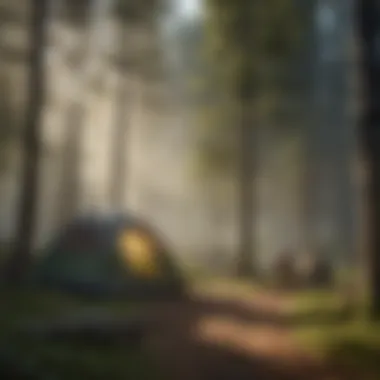Discovering the Nearest Campgrounds: Your Essential Guide


Intro
Camping offers a unique way to connect with nature, and the right campground can enhance that experience significantly. To select the ideal site, it is crucial to understand the local environment, the types of flora like evergreen trees, and the ecological dynamics at play. This comprehensive guide not only provides strategies for locating nearby campgrounds but also elucidates the importance of various tree species, particularly evergreen ones, in a camping experience. Knowing where to camp, what to look for, and the ecological factors at play can vastly improve your outdoor adventures.
In the following sections, we will examine key elements to consider when choosing a campground, the ecological significance of evergreen forests, and practical tips for responsible camping. These insights will equip the reader with knowledge essential for making informed decisions while planning their next outdoor excursion.
Understanding Campgrounds
Understanding the concept of campgrounds is vital for any outdoor enthusiast. Campgrounds serve as the foundational location where individuals connect with nature, unwind, and experience the outdoors. This knowledge is important as it informs your decisions when choosing a site for your next camping trip. Knowing the different types of campgrounds and their unique characteristics offers insights that help you align your preferences with available options.
Definition of Campground
A campground is a designated area, often equipped with facilities, for camping. The layout can vary widely, ranging from simple plots that offer minimal amenities to well-equipped locations with restrooms, showers, and fire pits. Camping sites can be described as temporary living arrangements for individuals or groups seeking a recreational experience amidst nature. Nearly all campgrounds offer some degree of proximity to nature, which is one of their primary appeals.
Types of Campgrounds
There are several types of campgrounds, each providing distinct experiences and facilities. Understanding these differences can greatly influence your choice and outdoor experience.
National Parks
National Parks are expansive protected areas that often attract campers looking for immersive natural experiences. These parks typically feature stunning landscapes, diverse ecosystems, and a rich array of wildlife. The main characteristic of National Parks is their emphasis on preserving the environment while allowing for recreational activities such as hiking, fishing, and camping. The uniqueness of these areas lies in their vastness and the deeply protected status they enjoy, making them a popular choice for serious nature enthusiasts. However, the demand for camping spots in National Parks can lead to overcrowding during peak seasons, and reservations may be required.
State Parks
State Parks can be likened to a more accessible version of National Parks, often situated within closer proximity to urban areas. They offer various recreational opportunities, including camping, hiking, and fishing. The key characteristic here is community accessibility; State Parks usually cater to families and local outdoor enthusiasts looking for a quick escape. While they typically have fewer natural wonders than National Parks, they often provide excellent facilities and services. The disadvantage may include variable funding and resources depending on the state, affecting the availability of maintenance and programs.
Private Campgrounds
Private Campgrounds are owned and operated by individuals or businesses. They often provide a wide range of amenities from basic camping to luxury options with cabins and RV hookups. One key aspect of private campgrounds is their tailored experiences; they may offer unique features such as organized activities or guided tours. This makes them an attractive choice for families or those seeking comfort. However, costs can be higher than public options, which may exclude budget-conscious campers.
Backcountry Sites
Backcountry Sites represent the extreme end of outdoor adventure. These sites are typically located away from established campgrounds and require some effort to reach, often involving hiking or climbing. The defining characteristic of backcountry camping is the isolation and authenticity it offers. Campers can expect to experience pristine environments and solitude. On the downside, these sites may lack facilities, meaning that campers must be well-prepared and self-sufficient. This type of camping appeals to those looking for adventure and a deeper connection with nature, but it can be less suitable for casual campers.
Secure a deep understanding of campgrounds and the amenities and experiences they offer. Knowing the differences helps ensure that you make informed decisions, enhancing your overall outdoor experience.
Importance of Location
Choosing the right location for a campground is essential for an enriching outdoor experience. Location influences not only accessibility but also the types of activities available to campers. Selecting a campground near natural resources enhances the adventure, enriching the stay with numerous opportunities for exploration and relaxation. Key elements like proximity to nature trails, access to water bodies, and potential for wildlife observation create the backdrop for memorable camping experiences.
Proximity to Nature Trails
A campground located near well-maintained nature trails offers easy access to hiking and exploring natural landscapes. These trails often showcase the local flora and fauna, providing an opportunity for campers to connect with nature. Being near trails promotes physical activity while also serving as a peaceful escape from daily life.
- Health Benefits: Hiking improves cardiovascular health and mental well-being.
- Scenic Views: Nature trails frequently lead to scenic overlooks or hidden gems that campers might not discover otherwise.
- Diversity: Trails with varying difficulty levels cater to all age groups and skill sets, making them inclusive for families and groups.
Access to Water Bodies
Having a campground near lakes, rivers, or coastal areas is advantageous for several reasons. Water bodies attract various recreational activities such as fishing, swimming, and kayaking. Experiences on the water enhance the overall camping enjoyment and create opportunities for relaxation.
- Recreational Activities: Fishing and canoeing can be leisure pursuits that also lead to social interactions among campers.
- Cool Retreats: Water bodies can offer a refreshing escape during hot summer months, making it comfortable to spend extended time outdoors.
Wildlife Observation Opportunities
Campgrounds ideally situated near wildlife habitats allow for unique opportunities to observe and respect nature. This proximity can inspire campers to learn more about biodiversity and the ecosystem.
"Understanding local wildlife behaviors can enrich the camping experience while promoting a sense of stewardship towards nature."
- Educational Potential: Witnessing wildlife up close can lead to educational discussions, especially beneficial for families with children.
- Photography: Providing exceptional opportunities for capturing memorable moments, wildlife observation can be a rewarding hobby for many outdoor enthusiasts.
In summary, thoughtful consideration of a campground's location enhances the camping experience. Proximity to nature trails, water bodies, and wildlife habitats contributes to the richness of outdoor adventures, encouraging exploration and connection with nature.
Finding the Closest Campground
Finding the right campground can greatly enhance your outdoor experience. When considering various camping options, proximity plays a crucial role. The closer the campground is, the more convenience you have in reaching it. Moreover, being near your desired location can provide better access to local attractions such as trails, lakes, and wildlife spots, thus enriching your overall time spent in nature.
With advancements in technology and increased access to information, locating the nearest camping sites has become easier than ever. Utilizing different resources can streamline the search process and ensure you find a campground that fits your needs. This section will explore various tools and platforms available for campers today.


Utilizing Online Tools
Finding the closest campground requires understanding how to use online tools effectively. Various applications and websites specialize in this task. Their features often make searching less complicated and much more efficient.
Camping Apps
Camping apps, such as Campendium and AllTrails, focus on helping users locate campgrounds. They are often user-friendly and provide valuable information like reviews and photos. One key characteristic is their ability to filter campgrounds based on criteria such as location, amenities, and user ratings. This customization makes them a popular choice for campers.
The unique feature of camping apps is their integration with GPS technology, which allows users to get directions directly to their selected campsite. However, one must consider that some apps may have limited information in remote areas, potentially affecting the decision-making process.
Web Portals
Web portals like Recreation.gov facilitate easy access to campground details. They present comprehensive listings, allowing users to search by state or feature. This characteristic enables campers to find sites quickly, making it easier to compare options. Furthermore, these portals hyperlink to additional resources such as reservation systems.
While the convenience of web portals is notable, one disadvantage lies in their sometimes overwhelming amount of information. Campers may find it challenging to sort through various listings, leading to decision fatigue.
Interactive Maps
Interactive maps, such as Google Maps, play a vital role in helping users visualize their surroundings. They help locate campsites while also showing the nearby points of interest, which adds value to the experience. A key aspect of interactive maps is their real-time updates, offering insights into road conditions and traffic.
Nonetheless, while they are highly beneficial, they may lack specific campground details, such as regulations and amenities. Users should cross-reference information from multiple sources for a complete picture.
Community Recommendations
Community recommendations can provide unique insights into the campground selection process. Engaging with fellow campers can yield valuable information that online tools may not have.
Social Media Groups
Social media groups focused on camping offer a space for enthusiasts to connect and share experiences. These platforms allow users to ask questions and receive recommendations based on real-life experiences. One characteristic of social media groups is their interactive nature, facilitating quick feedback from community members.
The unique feature here is the dynamic exchange of information. Users often share up-to-date details about campgrounds, including changes in conditions or amenities. However, a disadvantage can arise from varying opinions, which may lead to confusion. Thus, it can be necessary to weigh multiple perspectives before making a final decision.
Local Forums
Local forums such as those on Reddit provide another avenue for recommendations. These platforms give access to region-specific camping discussions, allowing for tailored advice depending on your location. One key characteristic of local forums is the depth of information shared. Campers provide detailed outlines of their experiences and preferences regarding specific sites.
The unique feature here is the sense of community that often forms around shared interests. However, it is crucial to remember that information can easily become outdated, so verification from other sources is advisable.
Local Outdoor Stores
Local outdoor stores can also be a useful resource in finding nearby campgrounds. Employees often have firsthand knowledge about local camping sites. Inquire about recommendations based on your interests and preferences. They may even have brochures or maps that show various campgrounds in the area. Furthermore, this option allows you to converse with someone knowledgeable about the local terrain and its features.
In summary, finding the closest campground can take advantage of various online tools and community insights. Leveraging camping apps, web portals, and social media groups can simplify this process. Additionally, utilizing local stores as a resource can enhance your search for the ideal camping spot.
Key Factors to Consider When Choosing a Campground
Choosing the right campground is crucial for any camping experience. A sanctuary in nature greatly influences how one appreciates and enjoys the outdoors. Each campground possesses distinct features that can significantly affect one's stay. Understanding these factors allows campers to align their needs and preferences with what each site offers. Moreover, evaluating the campgrounds' amenities ensures that the experience is not only enjoyable but also safe.
Facilities and Amenities
Restrooms
Restrooms represent a fundamental aspect of campground facilities. The availability of clean and accessible restrooms greatly enhances the comfort level during a camping trip. When selecting a campground, it is essential to check the condition of restrooms. Often, campgrounds with regular maintenance prove to be more hygienic and user-friendly. A unique feature of many well-maintained restrooms is the inclusion of amenities such as running water, hand soap, and even changing rooms. These qualities contribute to a more pleasant camping experience, making campgrounds more appealing choices for families and individuals alike.
Showers
Showers are another critical amenity that can make a significant difference. After a long day of outdoor activities, the ability to clean up and refresh oneself is invaluable. Campgrounds that offer showers usually provide hot water, which is a vital consideration during colder months. However, one must also consider the water usage policies in place, as some sites may limit shower times. This can affect how much one can truly enjoy their outdoor experience. Moreover, not all campgrounds have shower facilities, so this aspect should heavily influence the selection process.
Fire Pits
Fire pits are a defining element of the campsite atmosphere. They allow for cooking, warmth, and gathering, serving as a focal point for social interactions. The design can vary significantly; some are built-in, while others may be portable. Unique features include adjustable grills for cooking and safety measures to prevent wildfires. A campground that provides proper fire pits adds value to the stay, enabling visitors to enjoy quintessential campsite activities such as grilling or storytelling around the fire. However, it is important to respect the regulations surrounding fire use to ensure both personal safety and environmental protection.
Site Regulations
Quiet Hours
Quiet hours are an important consideration when selecting a campground. They serve to create a peaceful environment in which all guests can enjoy harmony with nature. Campgrounds that enforce quiet hours often establish designated times during which noise should be minimized. This ensures a restful experience, particularly for families with children or those seeking solitude. However, these regulations can limit social activities, which may deter certain visitors. Thus, understanding the specific quiet hours at a campground helps in anticipating how one will interact within the space.
Pet Policies


Pet policies are essential to consider for animal lovers. Many campers travel with their pets, and different campgrounds have varied rules regarding animals. Some sites embrace pets, allowing for their playful presence, while others impose restrictions or outright bans. Additionally, certain campgrounds may require pets to be leashed or may have designated areas. Understanding these regulations is key to ensuring a fun and worry-free experience with one’s furry friends. It can also affect the choice of a campground, as suitable options will dictate a visitor's comfort and peace of mind.
Accessibility
Accessibility is a vital aspect that can often be overlooked. When choosing a campground, it's important to consider how easily one can reach it. Factors such as road conditions, proximity to major highways, and terrain can significantly impact accessibility. More importantly, campgrounds should also be evaluated based on the facilities available for individuals with disabilities. Accessible restrooms, paths, and campsites enhance the opportunity for everyone to enjoy the outdoors. By prioritizing accessibility, campers ensure that they and their companions can fully participate in outdoor activities without hindrance.
Environmental Considerations
The significance of environmental considerations cannot be overstated in the context of camping. As people venture into nature, it becomes essential to acknowledge their impact on the surroundings. Understanding these elements helps preserve ecosystems and ensures sustainable enjoyment of outdoor spaces. This section will focus on two key aspects: Leave No Trace principles and the impact of camping on local ecosystems.
Leave No Trace Principles
The Leave No Trace principles are essential guidelines promoting responsible outdoor ethics. These principles empower campers to minimize their ecological footprint. They encompass a variety of actions and behaviors intended to protect and conserve the environment.
Key principles include:
- Plan Ahead and Prepare: Effective planning can significantly reduce the likelihood of human impact on the environment. Understand the area, check regulations, and gather crucial information about the site.
- Travel and Camp on Durable Surfaces: Stick to established trails and designated campsites. This reduces erosion and protects native vegetation.
- Dispose of Waste Properly: Pack out all waste, including food scraps and trash. For human waste, consider using a toilet facility when available.
- Leave What You Find: Preserve the natural environment by not removing plants, rocks, or artifacts.
- Minimize Campfire Impact: Use a camp stove for cooking instead of a campfire, unless fire regulations permit it. If a fire is necessary, use established fire rings.
- Respect Wildlife: Observe animals from a distance. Feeding wildlife disrupts their natural habits and can be harmful.
- Be Considerate of Other Visitors: Keeping noise levels down and respecting others' space is key to a positive outdoor experience.
"Practicing these principles not only safeguards our natural spaces but also enhances the camping experience for future visitors."
Impact on Local Ecosystems
Camping directly affects local ecosystems—both positively and negatively. It is important for campers to understand these impacts to engage in responsible outdoor behavior.
Positive impacts can include:
- Ecosystem Awareness: Camping fosters a deeper appreciation of nature. This awareness can lead to more advocacy for environmental conservation.
- Support for Conservation Efforts: Campers often contribute financially to parks, which helps with conservation and maintenance efforts.
Negative impacts can include:
- Erosion: Trampling from foot traffic can harm delicate plant life, leading to soil erosion. This is especially true in popular areas with heavy foot traffic.
- Wildlife Disturbance: Camping can encroach on wildlife habitats. Noise and food waste can alter animal behavior, leading to dependency on human food sources.
- Pollution: Littering and improper waste disposal degrade both the beauty and health of environments. This pollution impacts plants and animals alike.
Understanding these impacts is essential. Campers can protect the environment with informed practices. By recognizing their footprint, they can actively contribute towards preserving the beauty and health of camping locations.
Planning Your Campground Visit
Understanding how to plan your camping visit is critical for enjoying a successful outdoor experience. Proper preparation can minimize stress and maximize enjoyment. It allows individuals to focus on their surroundings and participate in the natural beauty that camping offers. Effective planning involves understanding the essentials needed for a smooth trip and preparing for any potential challenges. This section will cover equipment you need, safety precautions, and how to ensure a memorable visit with nature.
Equipment Checklist
Shelter
Shelter is the cornerstone of any camping trip. It not only provides a place to sleep but also protects campers from weather elements, insects, and wildlife. The most common choices include tents, hammocks, and recreational vehicles. Tents are popular because they are lightweight and easy to set up. A good tent should have a durable waterproof cover. This feature ensures comfort during rain or unexpected weather changes. However, a tent can be challenging to set up in rough terrain. Considering shelter type impacts the overall success of your trip.'
Food Supplies
Having the right food supplies is essential for an enjoyable camping experience. It is important to pack items that are easy to prepare and store. Freeze-dried meals, canned goods, and fresh fruits are excellent choices. You want to choose items that require minimal cooking effort. The unique feature of pre-packaged meals is their lightweight nature and long shelf life, making them convenient for outdoor adventures. However, these meals can lack flavor compared to home-cooked alternatives. Striking a balance between convenience and taste will enhance your camping experience.
Cooking Gear
Cooking gear contributes significantly to your camping visit as it facilitates meal preparation. Essential items include portable stoves, cooking utensils, and coolers. A portable stove can be particularly beneficial because it offers a reliable way to cook in various weather conditions. Moreover, the convenience of cooking gear means that campers can enjoy hot meals that elevate their outdoor experience. Nonetheless, the use of cooking gear requires a mindful approach to fire safety and local regulations.
Safety Precautions
Wild Animal Encounters
Understanding how to handle wild animal encounters is necessary for a safe camping experience. Campers often attract animals by leaving out food or waste. A key characteristic of being prepared is knowing the specific wildlife in the region and how to avert encounters. Properly storing food and using bear-proof containers can help prevent unwanted guests. Being educated about local wildlife will allow for a more enjoyable and worry-free trip. However, ignoring these precautions could lead to dangerous situations.
Weather Preparedness
Weather can be unpredictable, especially in outdoor settings. Preparing for various weather conditions is essential. This means checking forecasts before leaving and bringing appropriate clothing. The unique aspect of weather preparedness is the ability to adapt to changing conditions, such as sudden rain or temperature shifts. Having layers of clothing and waterproof gear can improve comfort during weather changes. Not being prepared can lead to unpleasant experiences, affecting the overall enjoyment of the trip.
Planning reduces stress and enhances enjoyment in nature.
In summary, thoughtful planning and appropriate gear can set the tone for a successful camping trip. By gathering the necessary equipment and considering safety precautions, campers can focus on experiencing the great outdoors.
Maximizing Your Outdoor Experience
Maximizing your outdoor experience is crucial for anyone planning to visit a campground. It encompasses various activities that allow campers to connect with nature, foster camaraderie, and develop new skills. Engaging fully with the outdoor environment enhances one’s appreciation for natural beauty and encourages a healthier lifestyle. This section highlights how specific activities contribute to an enriched camping experience.


Engaging with Nature
Birdwatching
Birdwatching is an engaging activity that draws many nature lovers. This hobby involves observing and identifying different bird species in their natural habitats. The key characteristic of birdwatching is its accessibility; it can be enjoyed from almost anywhere within a campground, even from one's campsite. This immediate interaction with the surrounding ecosystem makes it an appealing choice for campers seeking a unique experience.
Additionally, birdwatching promotes mindfulness. Campers often find themselves immersed in the calmness of nature, focusing on the various sounds and movements in their environment. One distinctive feature of birdwatching is the equipment required, primarily binoculars and a field guide to assist in identification. This simplicity allows for spontaneous excursions without extensive planning.
However, birdwatching has its disadvantages; conditions such as weather and habitat disturbance can significantly affect bird visibility. Campers must remain patient and adaptable to make the most out of this endeavor. While it draws many, not everyone may share the enthusiasm for quiet observation.
Hiking
Hiking provides a direct and engaging way to explore the landscapes surrounding a campground. A key aspect of hiking is its physical benefits. It promotes fitness while offering an immersive experience in nature that is hard to replicate through other activities. Hiking trails often lead to scenic viewpoints or hidden gems within a park, enhancing the sense of adventure.
The unique feature of hiking is its versatility; trails range from easy walks to challenging treks. Thus, it caters to all levels of experience and can be enjoyed individually or in groups. The camaraderie established while hiking often leads to shared experiences and lasting memories.
However, hiking does require proper planning and awareness of trail conditions. It can present challenges such as steep inclines or uneven terrain. Campers need to prepare adequately to ensure safety and enjoyment. The physical exertion involved might not appeal to everyone, especially those preferring less strenuous activities.
Campsite Activities
Campfire Stories
Campfire stories are a traditional and communal aspect of campground culture. This activity involves gathering around a fire to share anecdotes or folklore. The key characteristic of campfire stories is their ability to foster connection among participants. It creates a shared experience that can bond families and friends. This communal sharing of tales often enhances the emotional aspects of a camping trip.
What makes campfire stories particularly beneficial is the relaxing environment they provide. As the sun sets and the fire crackles, campers feel a sense of warmth and togetherness. The unique feature here is the storytelling element, which varies greatly depending on the tellers. Each individual brings their experiences and perspectives, enriching the group dynamic.
Yet, telling stories requires participation and engagement, which some may find daunting. Not everyone may feel comfortable sharing tales, therefore limiting this activity's reach. Despite this, it remains popular because of the personal connections formed around the campfire.
Cooking Together
Cooking together enhances the camping experience by promoting teamwork and creativity. This activity revolves around preparing meals as a group, allowing participants to bond over shared responsibilities. A key characteristic of cooking together is the joy of collaborating, creating dishes often influenced by local ingredients or personal preferences.
The unique feature of this activity is that it not only satisfies hunger but also allows for experimenting with recipes and techniques. Campers can explore outdoor cooking methods, such as grilling or using a Dutch oven, making it a fun and memorable experience.
However, cooking does require planning and coordination among the group. Supply shortages or kitchen mishaps can lead to frustration. Nevertheless, the camaraderie and satisfaction felt after a shared meal often outweigh any minor setbacks. Cooking together is a popular choice and cements the social aspect of camping.
Engaging in these activities not only enriches your camping experience but also allows you to develop skills and create lasting memories.
Post-Camping Reflection
Reflecting after a camping trip is an essential part of the overall experience. This phase enables campers to internalize what they learned, both from the environment and the community. Evaluating each trip can lead to better future decisions regarding gear, location, and planning. Moreover, it forms a bridge between personal growth and knowledge sharing within the broader camping community.
Evaluating Your Experience
Evaluating your experience involves taking a moment to consider the highlights and challenges of your trip. Focus on various aspects such as:
- Site suitability: Did the campground meet your expectations? Consider factors like cleanliness, accessibility, and amenities.
- Activities enjoyed: Reflect on what you liked best. Was it the hiking, the solitude, or perhaps the company?
- Lessons learned: Each trip presents unique opportunities to learn. Did you discover new skills or learn about nature?
This evaluation can help you build on your experiences. It also fosters a deeper connection to the outdoors and significantly influences your future camping choices.
Sharing Insights with Others
Online Reviews
Online reviews have become invaluable in the modern camping landscape. These reviews provide insights from fellow campers that can alter or affirm your choices. The main characteristic of online reviews is their accessibility; they are widely available on platforms like Facebook and Reddit. These reviews help potential campers gauge the quality of different campgrounds.
- Benefits: The primary advantage of online reviews is that they offer firsthand accounts from a diverse range of visitors. This can highlight both the pros and cons of a location, enabling future campers to make informed decisions.
- Drawbacks: However, not all reviews are equally beneficial. Some may be biased, reflecting a personal grievance rather than a comprehensive assessment.
The balance of information found in online reviews makes them a popular choice for assessing campgrounds.
Personal Blogs
Personal blogs are another rich source of information regarding camping experiences. They often offer in-depth narratives that promote emotional engagement and understanding. The key feature of these blogs is their personal touch, as they convey individual experiences and perspectives.
- Benefits: Personal blogs provide detailed accounts from the camper’s point of view. Insights shared often go beyond basic reviews, describing the ambiance, interactions, and surprise encounters with nature that shape memorable trips.
- Drawbacks: It's important to recognize that personal blogs can be highly subjective. A writer's biases may color their descriptions, which means these narratives should be read with a discerning mind.
The End
The conclusion of this article emphasizes the significant role campgrounds play in outdoor recreation and nature preservation. Campgrounds provide not only spaces for leisure but also opportunities for personal reflection and connection with the environment. Understanding the importance of campgrounds helps foster responsible camping habits, which are vital in maintaining the integrity of natural ecosystems.
Revisiting the Importance of Campgrounds
Campgrounds serve as essential gateways to nature. They offer a structured environment for individuals, families, and groups to engage with the outdoors while minimizing their impact on wilderness areas. In revisiting the value of campgrounds, several key elements emerge:
- Accessibility to Nature: Well-located campgrounds facilitate access to hiking trails, lakes, and scenic views. This aspect is crucial for campers seeking a blend of adventure and relaxation.
- Social Interaction: Campgrounds often host a diverse community of travelers. This setting encourages socialization, fostering a sense of belonging and shared experience.
- Educational Opportunities: Many campgrounds provide resources for learning about local flora and fauna. Engaging in guided programs can enhance understanding of environmental conservation.
- Mental and Physical Well-Being: Studies show that spending time in natural settings can reduce stress, boosting mental health. The campfire atmosphere, combined with physical activities like hiking or fishing, promotes overall well-being.



